
Sultanahmet is the historical district of Istanbul, which is the most popular place in the city, where the main attractions are concentrated, representing a magnificent ensemble.
Sultanahmet district is part of the large Fatih district and, in fact, a microdistrict. Sultanahmet is located in the European part of Istanbul, on a promontory between the Golden Horn Bay, the Bosphorus Strait and the Sea of Marmara.
The current area and the surrounding area are full of the most important sights of Istanbul and are located in the heart of the historical center of the city, where the ancient acropolis was once located on the first hill of the Second Rome (Constantinople, and now the city of Istanbul). The structures of the acropolis in the 15th and 16th centuries were gradually dismantled for the construction of new objects, including palaces Topkapi and Ibrahim Pasha.
The center of the district is the Sultanahmet Square of the same name (Sultanahmet Meydanı), which is located on the site of an ancient Hippodrome, the construction of which was started by Roman Emperor Septimius Severus in 203, when the city was still called Byzantium. Chariot races were held at the hippodrome. Therefore, the square has a second name "Hippodrome Square" (At Meydanı).
The name of the district and the square "Sultanahmet" comes from the Sultanahmet Mosque of the same name, better known as The Blue Mosque, which was erected by order of Sultan Ahmed I.
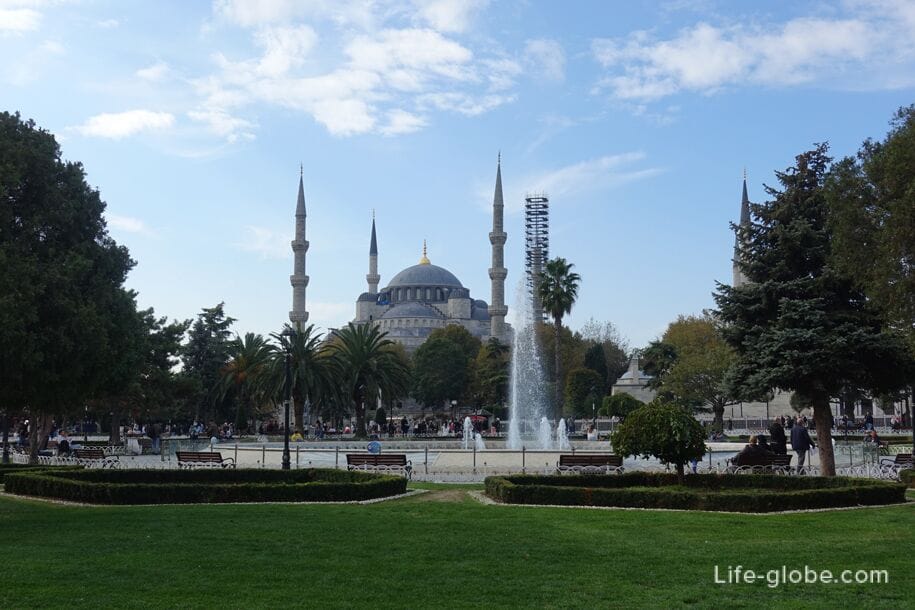
In addition to attractions, Sultanahmet and the surrounding area also attract the attention of tourists with colorful streets, a variety of restaurants and accommodation facilities (hotels, apartments)
In 1985, the historical part of the district, together with other historical sites of Istanbul, was included in the UNESCO World Heritage List.
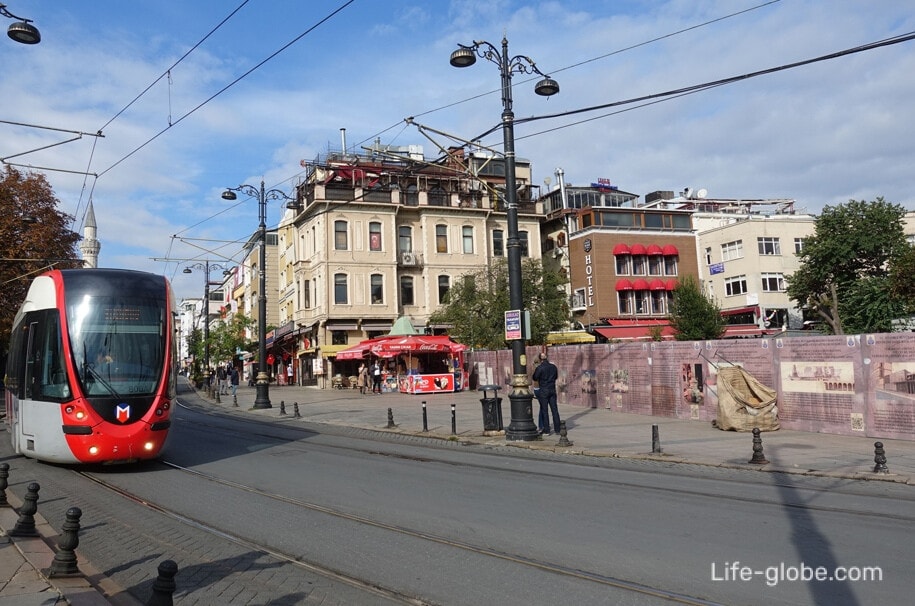
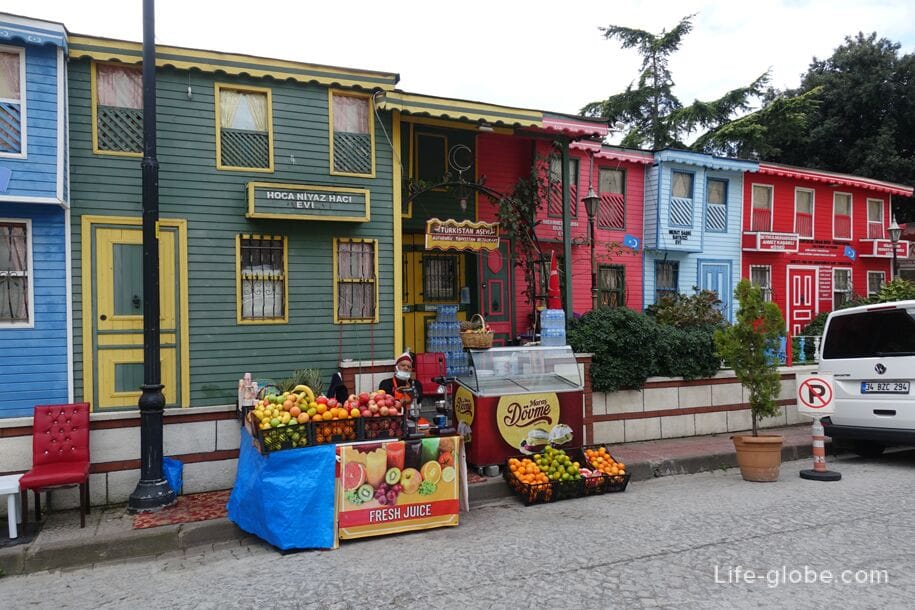
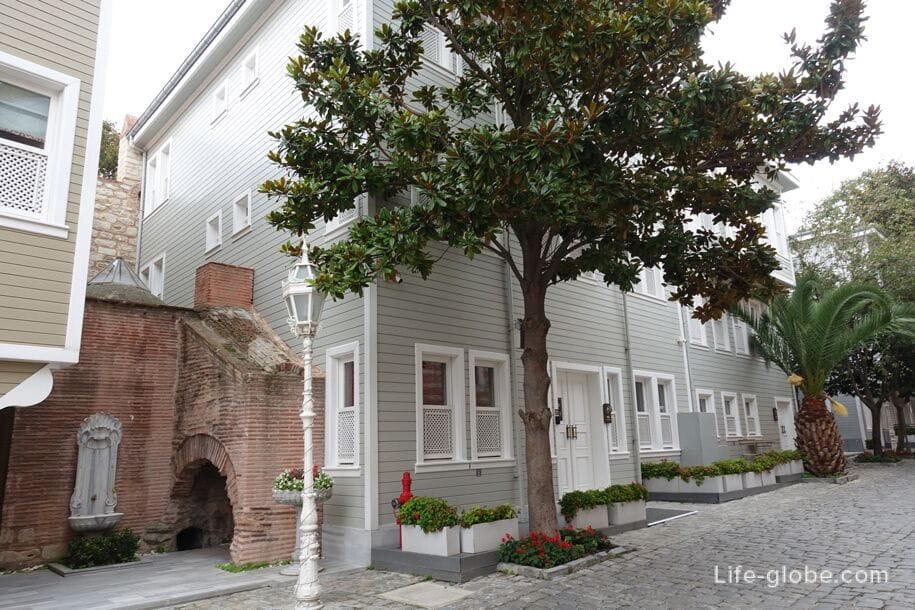
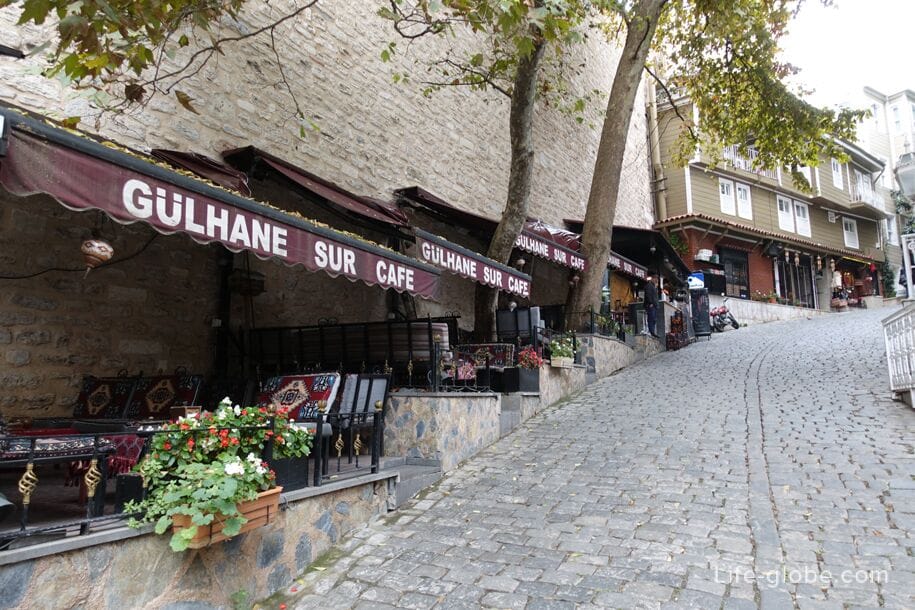
Sultanahmet Square is the main square of Istanbul and a unique monument of the Byzantine period, which in our time is a square-square, where few and silent witnesses of the Byzantine period have been preserved.

The Hippodrome Square is notable for:
- The obelisk of Constantine (Konstantin Dikilitaşı, Öme Dikilitaş) is a Byzantine obelisk that was erected from stone blocks, most likely by order of Emperor Constantine the Great.
In the middle of the 10th century, the obelisk was restored under Emperor Constantine Porphyrogenitus.
The original height of the obelisk was 32 meters, and it was covered with bronze (according to another version - copper) sheets, which were melted down by the Crusaders during the Fourth Crusade (1204).
Currently, the height of the column is 21 meters;
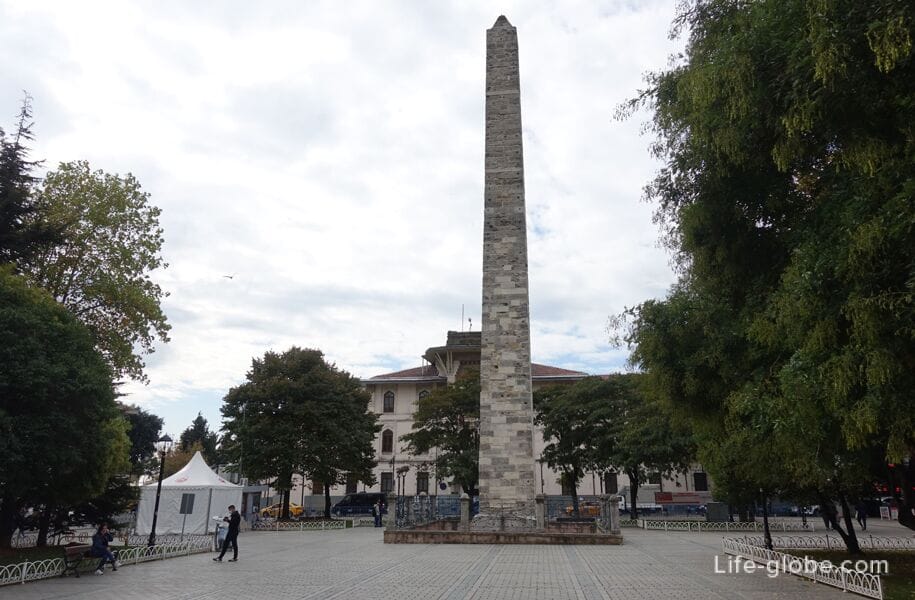
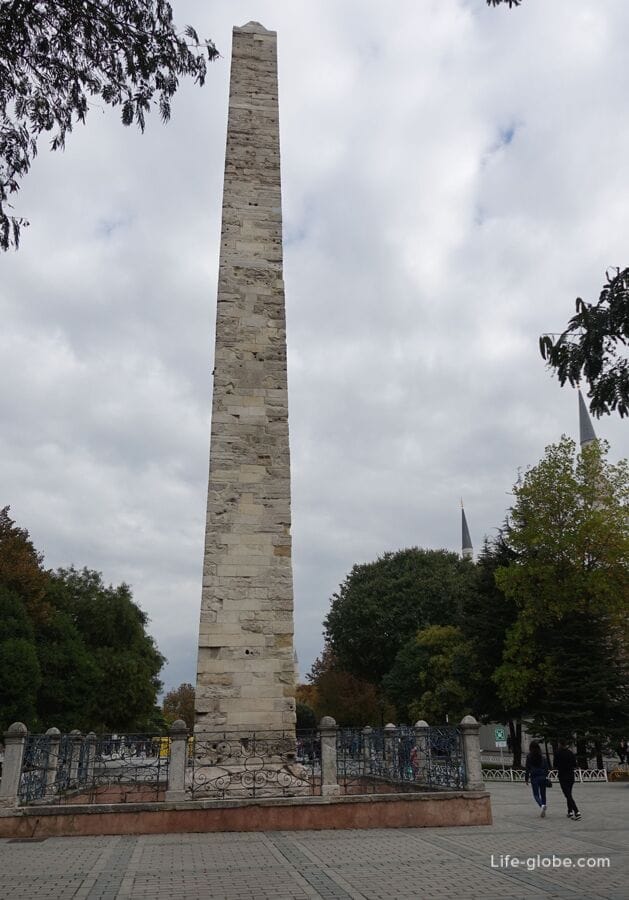
- Snake Column (Yılanlı Sütun) - remains of an ancient Greek column that had three snake heads, now lost.
The column was brought from the Delphic sanctuary of Apollo to Greece to Constantinople in 326 by order of Emperor Constantine the Great.
Until 1700, the column was crowned with three snake heads. The upper part of one of the snake heads is on display in the Archaeological Museum of Istanbul.
Currently, the height of the column is 5 meters;
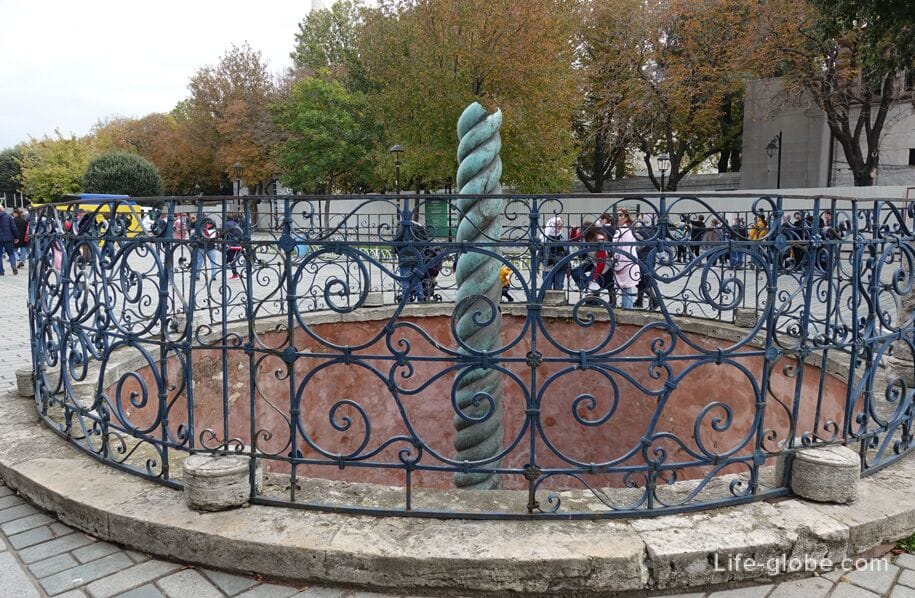
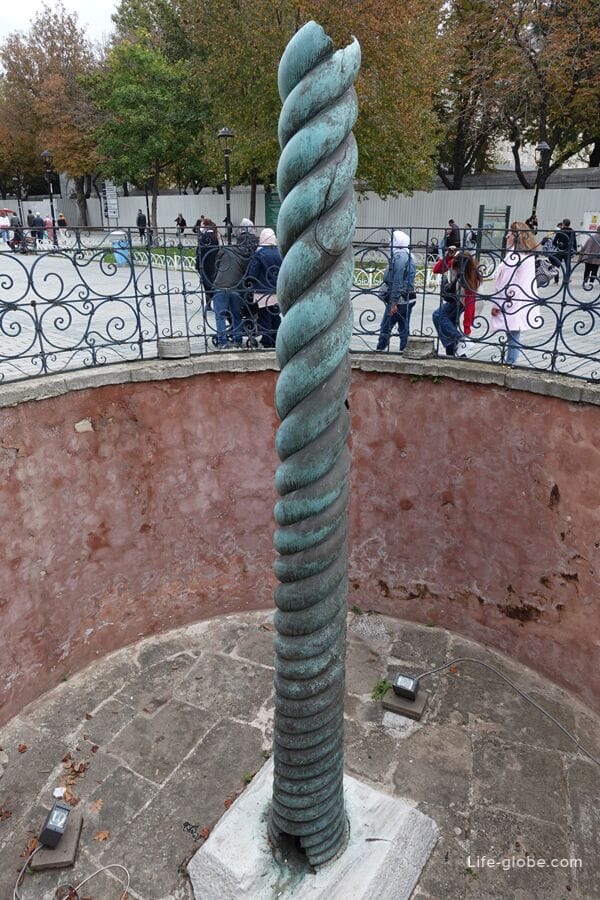
- Theodosius Obelisk or Egyptian Obelisk (Dikilitaş) is an ancient Egyptian obelisk of Pharaoh Thutmose III, brought from Luxor (Egypt) in 390 by order of Emperor Theodosius I and installed at the Hippodrome on a specially made marble pedestal.
Initially, before the transportation to Istanbul, the obelisk was created and installed in 1460 BC in the southern part of the Great Temple of Atum-Ra-Amon, Thebes, at the seventh pylon.
The obelisk is a four-sided monolith of pink Aswan granite (Sienese quarry), the upper part of which ends with a regular four-sided pyramid, and at the base there is a square pedestal. All four sides of the obelisk are covered with Egyptian hieroglyphs and on the upper fragment there is a figure of Pharaoh Thutmose holding hands with the Egyptian god Amon-Ra.
On the pedestal of the obelisk, consisting of two parts, scenes are carved: the emperor and his court (north side); chariot race (south side); submission of barbarians (west side); a scene in the circus (east side).
The height of the obelisk is 18.54 meters; together with the pedestal - 25.6 meters;

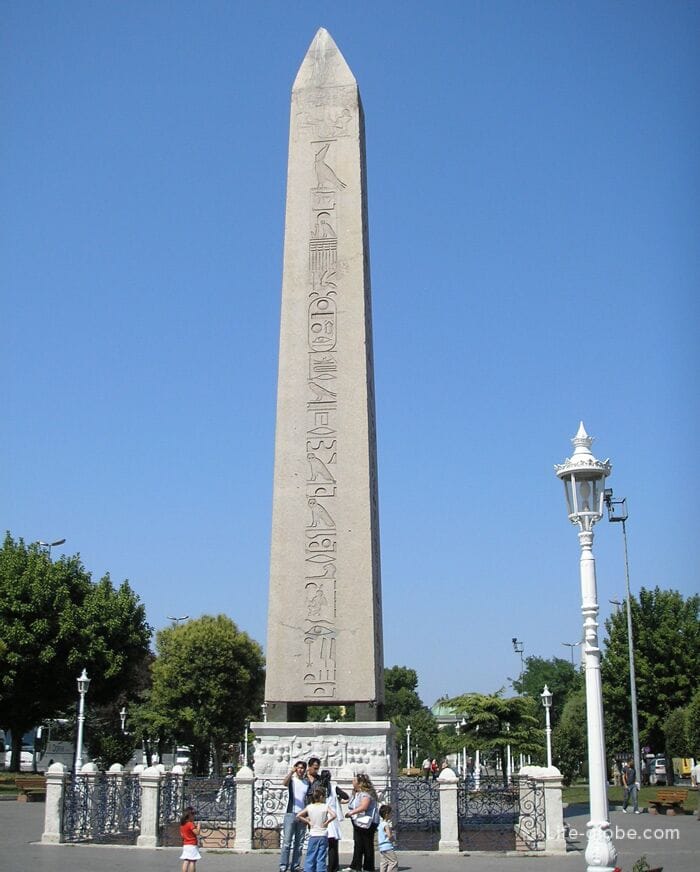
- German Fountain (Alman Çeşmesi) - created in in 1898 and presented by the German Kaiser Wilhelm II, who visited Istanbul.
The fountain is made in the neo-Byzantine style in the form of an octagonal gazebo with columns supporting the dome. The fountain is decorated with floral motifs and mosaics on the inside. On the inside of the dome there is a monogram of Sultan Abdul Hamid II and the initials of Kaiser Wilhelm II.

Around the square there are such buildings as:
- Ibrahim Pasha's Palace (Ibrahim Paşa Sarayı) is a monument of Ottoman architecture of the 16th century and the former residence of the Grand Vizier of the Ottoman Empire, Pargala Ibrahim Pasha.
The palace got its name from Ibrahim Pasha of Pargali (1494-1536), the son-in-law and grand Vizier of Suleiman the Magnificent, who lived in it.
After the execution of Ibrahim Pasha, the palace was the residence of subsequent grand viziers. Later it housed an embassy, sewing workshops, a military band and a prison.
From 1938 to the present, the palace has housed the Museum of Turkish and Islamic Art (Türk ve Islam Eserleri Müzesi) with collections of ceramics, sculpture, glass, wood, stone, metal, miniatures, masterpieces of calligraphy, historical documents, carpets with rare specimens, jewelry.
Entrance to the museum-palace is paid.
The museum's website: muze.gov.tr/muze-detay;
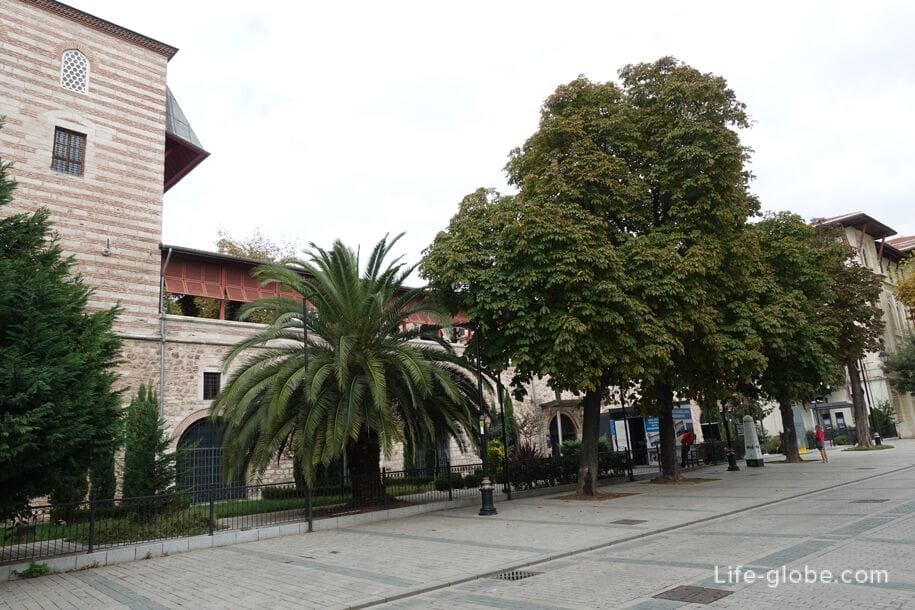
- The Republican Museum of Marmara University (Marmara Universitesi Cumhuriyet Muzesi), which consists of an art gallery, where short-term exhibitions are held, and the Ihapa Hulusi Gerey Gallery.
Website: cumhuriyet-muzesi.
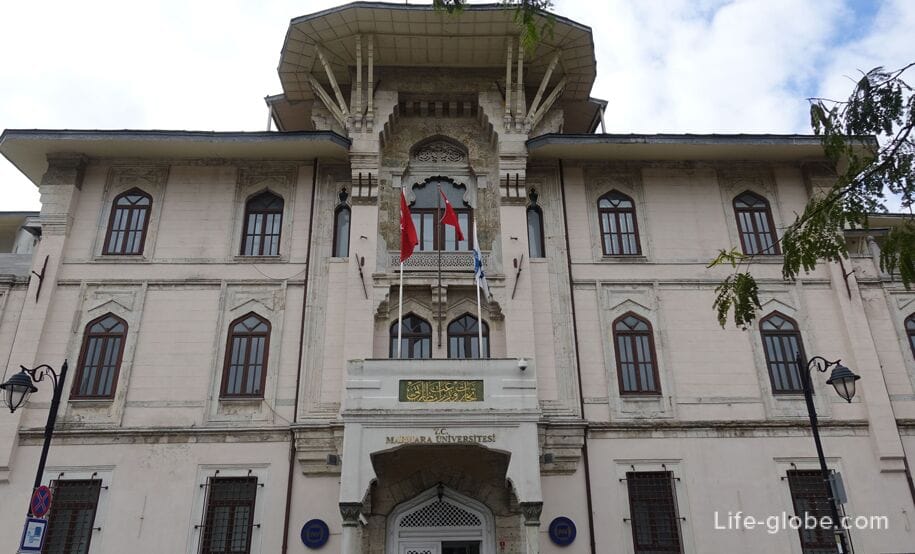
The Blue Mosque or Sultanahmet Mosque (Sultanahmet Camii / Sultan Ahmet Camii) is a historical imperial mosque, which is the first mosque in the city, and is also considered an outstanding example of Islamic and world architecture.
The mosque is known primarily for its six minarets and interior decoration, which is considered a masterpiece.
Today it is a functioning mosque, which is included in the UNESCO World Heritage List and attracts numerous tourists.
Entrance to the mosque is free (free). More about the Blue Mosque...
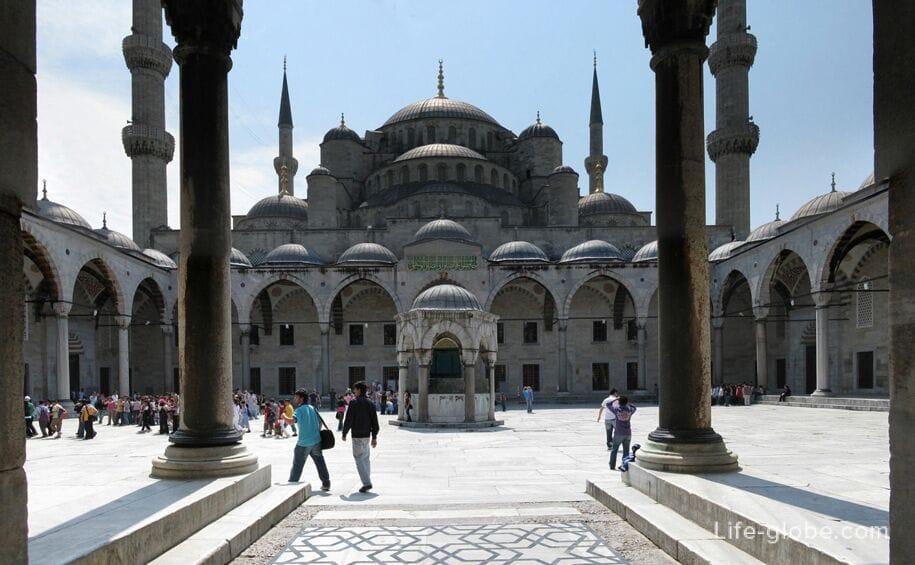
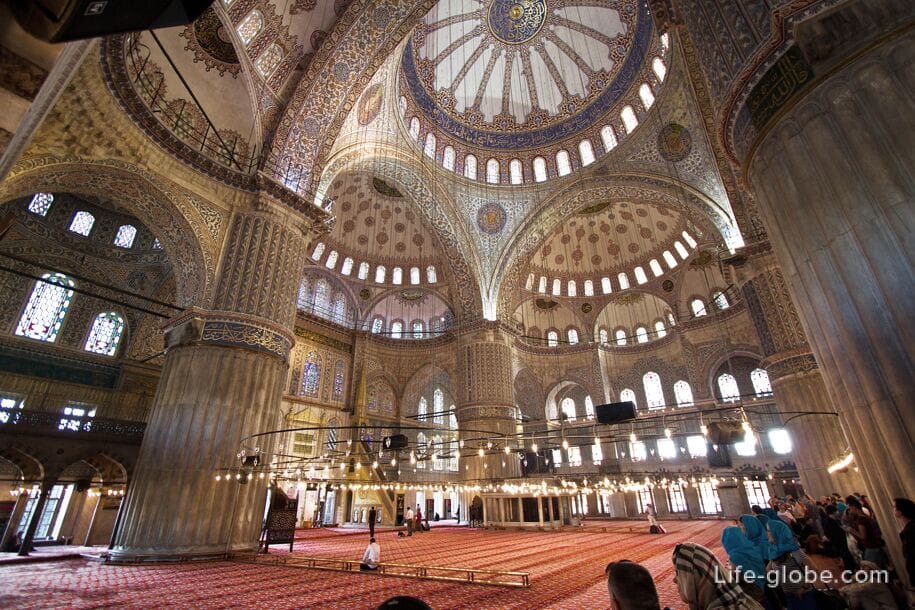
The Mausoleum of Ahmed I (Sultan Ahmet Türbesi) is the tomb where Sultan Ahmed I, his wife and children, as well as other representatives of the Ottoman dynasty rest.
The construction of the tomb-mausoleum began after the death of Sultan Ahmed I, and lasted three years.
The mausoleum is a monumental building with a domed roof and an arcade-entrance in the form of a three-part portico. It has a square layout, the facades of which are lined with marble.
The mausoleum is part of the architectural complex of the Blue Mosque.
Admission is free. More about the mausoleum of Sultan Ahmed I...
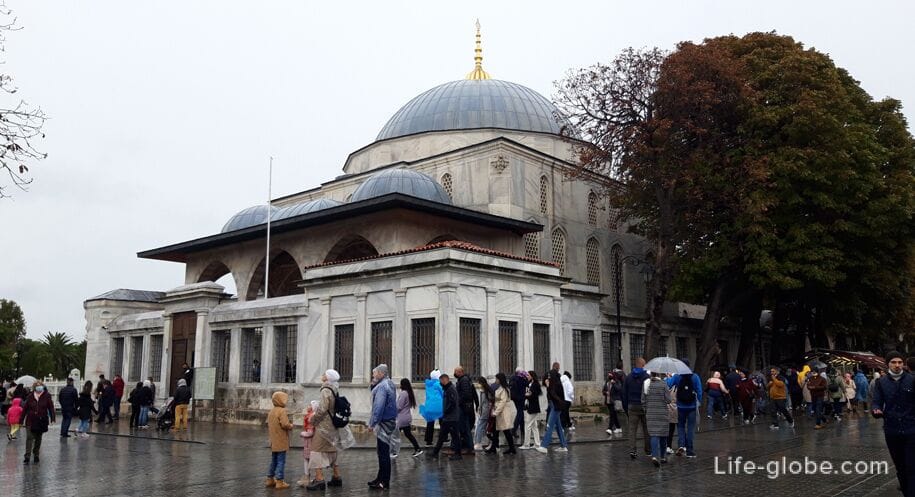
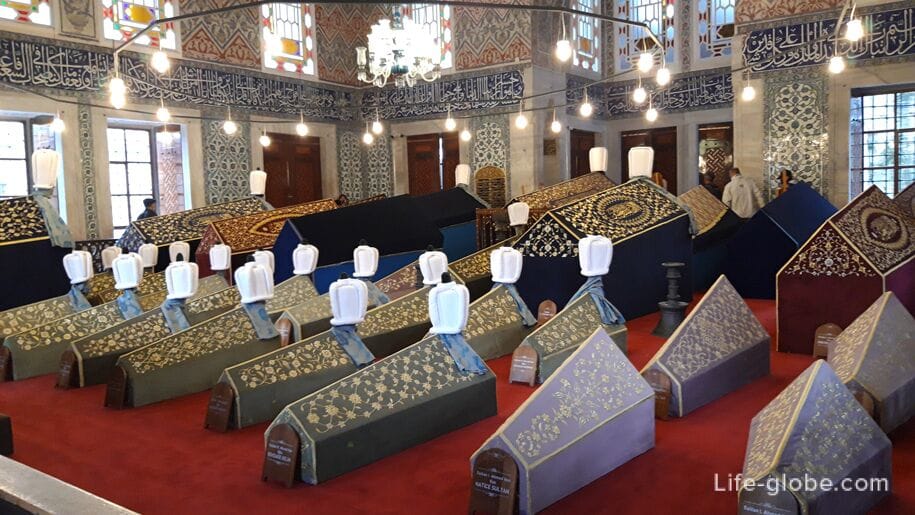
Arasta Bazaar (Arasta Çarşısı) is one of the oldest markets in Istanbul, which now consists of one small street near the Blue Mosque.
On both sides of the street there are cozy small shops selling things, carpets, dishes, Turkish goods, souvenirs, etc. Learn more about the Arast Bazaar...
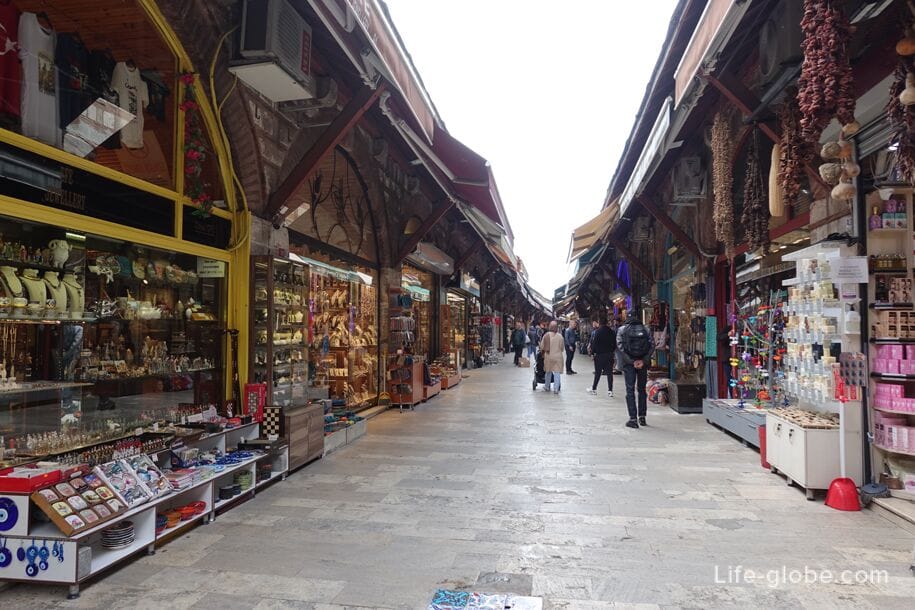
The Museum of Mosaics of the Grand Palace (Büyük Saray Mozaikleri Müzesi) is a museum of collections of mosaics from the time of the Byzantine Empire, discovered on the site of the Grand Imperial Palace of Constantinople.
Now there is no Grand Palace, but previously it was a huge palace complex that served as the main residence of the Byzantine emperors for eight hundred years (from 330 to 1081).
The Mosaic Museum is one of the largest and most diverse landscape images preserved since late antiquity. The mosaics, according to research, date back to a period somewhere between 450-650 years of our era. Most likely, the mosaics were created under the Byzantine emperor Justinian I, in the first half of the 6th century.
Entrance to the mosaic museum is paid; from the Arast Bazaar.
The museum's website: muze.gov.tr/muze-detay. Learn more about the Grand Palace Mosaic Museum...
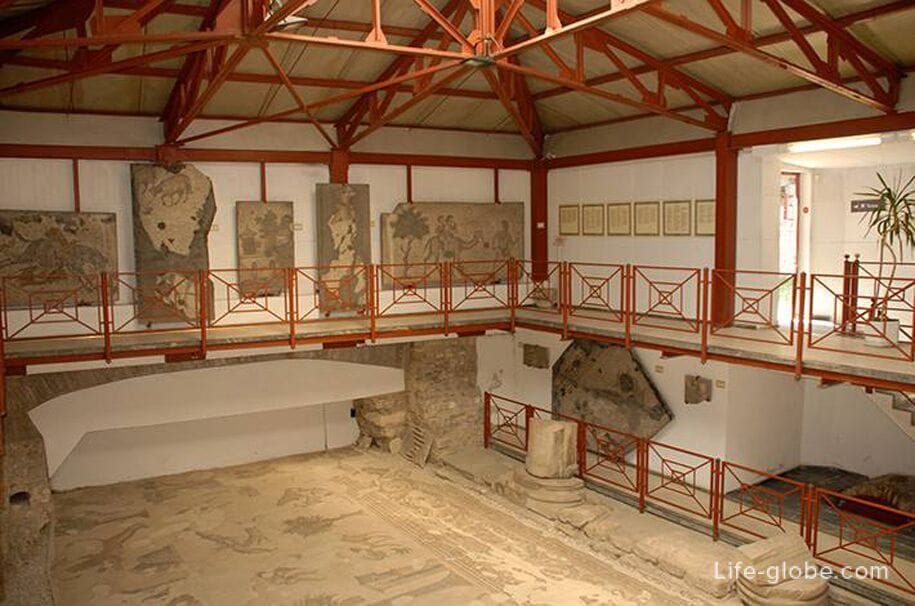
Sultan Ahmet Parkı is part of the Hippodrome Square and is a park area with a fountain and places to relax, located between Hagia Sophia and the Blue Mosque.
The center of the square is decorated with a dancing fountain (Sultan Ahmad Maydan Fountain), which is illuminated in the evening.
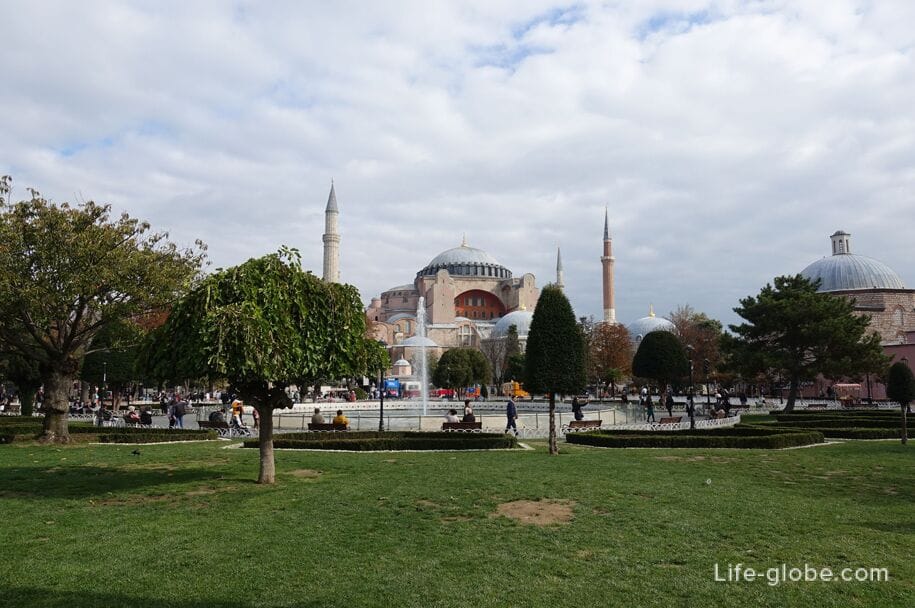

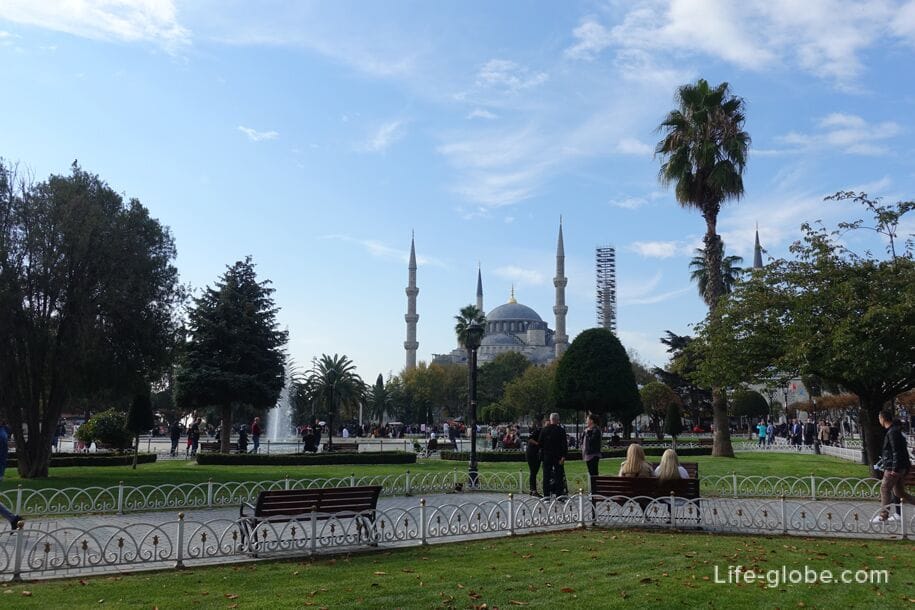
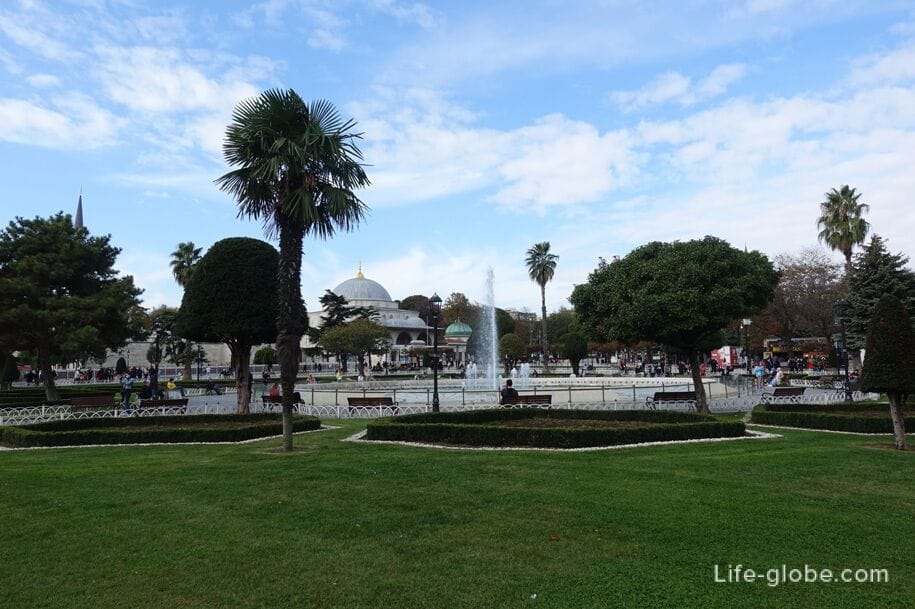
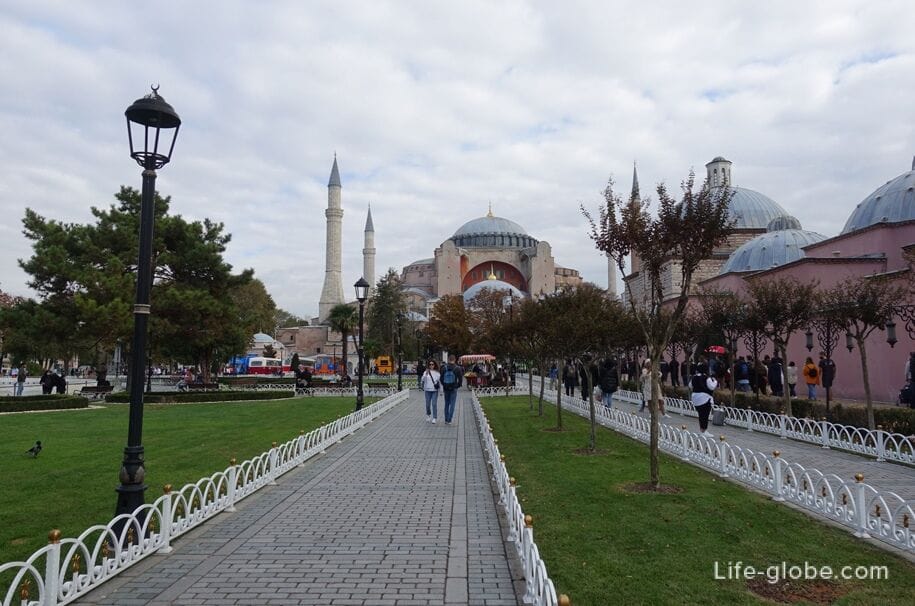
Hagia Sophia or Hagia Sophia (Ayasofya) is a mosque in Istanbul, which during its history has been an Orthodox church, mosque and museum.
The mosque is one of the greatest world-famous monuments and examples of Byzantine culture, as well as a symbol of the "golden age" of Byzantium.
Hagia Sophia has mausoleums, tombs, four minarets, and the giant dome system of the mosque with arched windows is a masterpiece of architectural thought of its time.
The interior of Hagia Sophia has absorbed several cultures and religions: inscriptions in Scandinavian runes, unique Orthodox mosaics, Islamic mihrab, Sultan's lodge and minbar. The "Weeping Column" also attracts attention, which, according to legend, cures diseases and fulfills wishes.
Entrance to the mosque is free. More about the Hagia Sophia Mosque...
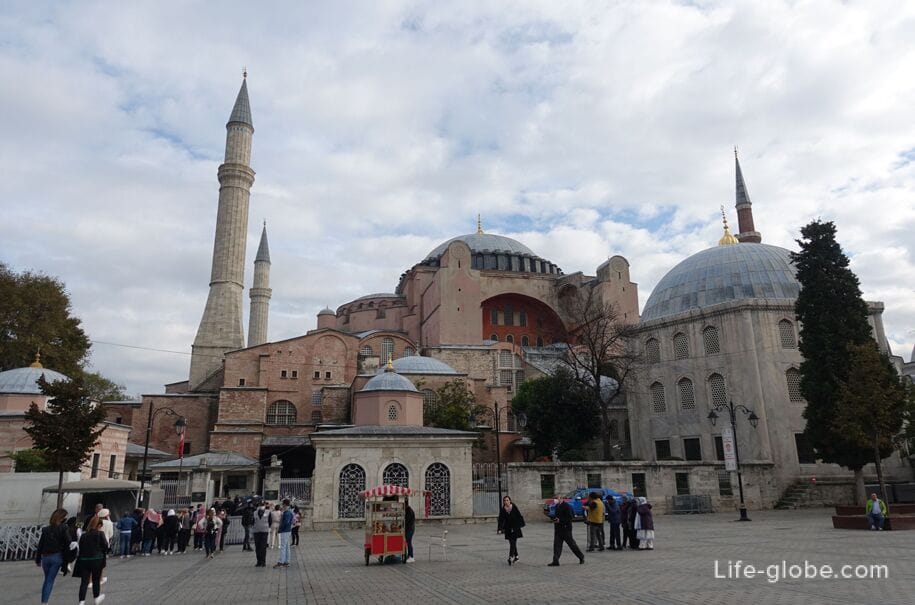

Hammam Hürrem Sultan (Hürrem Sultan Hamamı) - historical Turkish baths built in the 16th century for the beloved and legendary wife of Suleiman the Magnificent - Roksolana.
The hammam was designed and built in 1556-1557 by the chief architect of the Ottoman Empire, Mimar Sinan.
In the historic building of the Khurrem Sultan hammam, there is still a hammam, as well as a cafe-restaurant.
Hammam website: hurremsultanhamami.
The hammam is located near Sultan Ahmet Park. Learn more about the Khurrem Sultan Hammam...
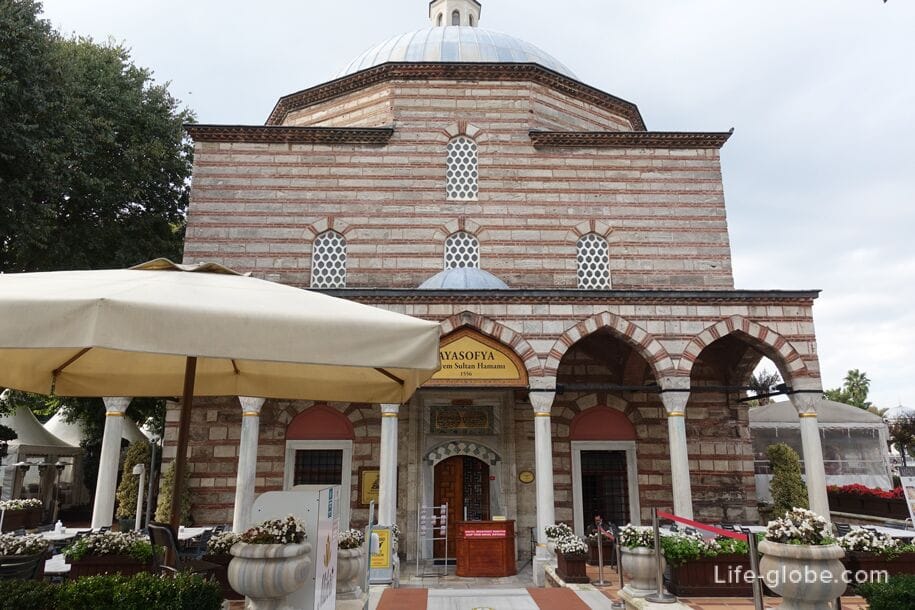
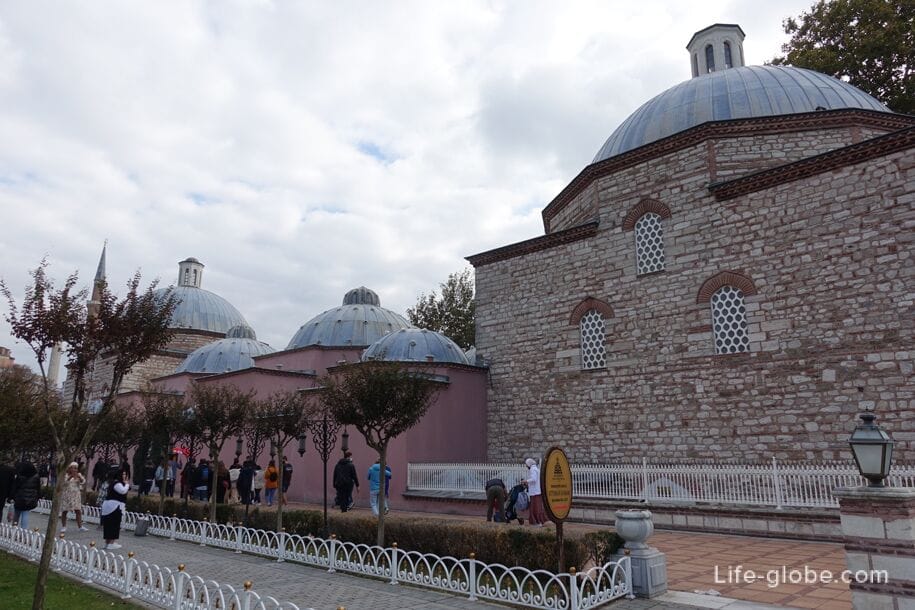
The Milyon Column or Zero Column (Milyon Taşı) is an element of the monument of the 4th century, which served as a marker of all ancient Roman roads leading to Constantinople in the Byzantine Empire, and the zero point used when calculating the distance from other cities of the world to this place.
It is believed that the mark was established by Emperor Constantine I in the 4th century.
The column is located near Hagia Sophia.
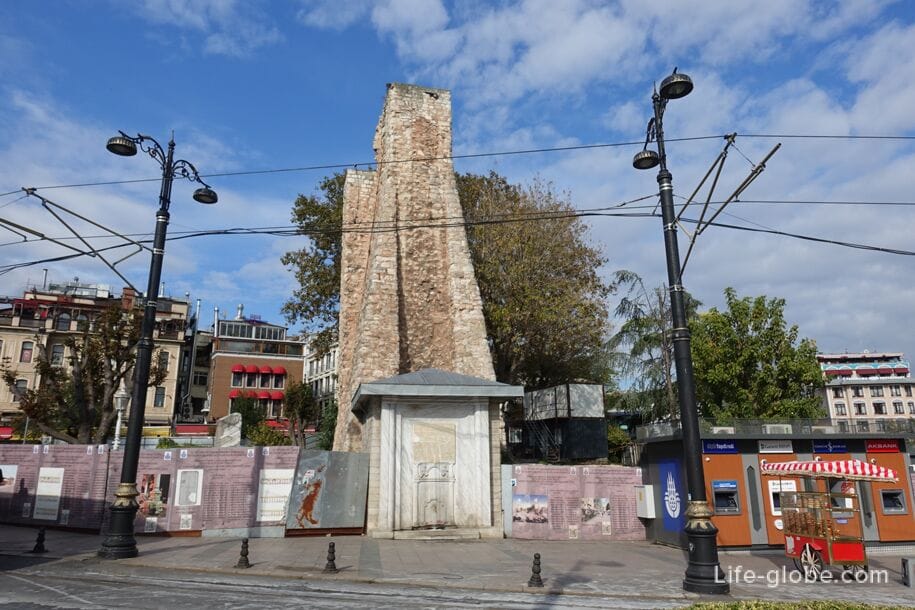
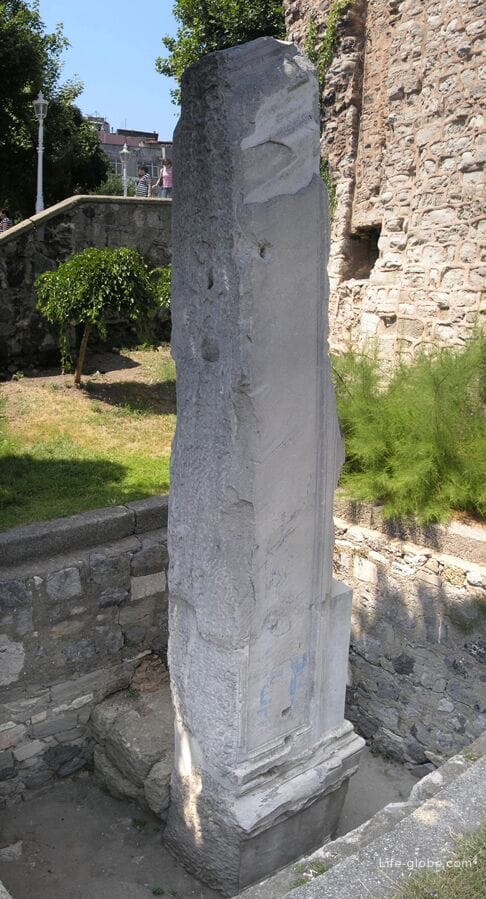
The Basilica cistern or Yerebatan Cistern (Yerebatan Sarnıcı) is one of the most famous, large and well-preserved underground reservoirs of Constantinople.
The cistern was built under the Byzantine Emperor Justinian I and was popularly called the "cistern-palace" because of the marble columns rising from the water, seemingly countless. The name "Basilica cistern" comes from the fact that there was a basilica at this place.
The cistern is a large underground structure with columns, one of which is called the "Crying Column" or "Column of Tears". It got this name due to the fact that, unlike other columns in the tank, it always remains wet, and there are patterns on its surface that resemble tear drops in shape.
The cistern is also notable for the two heads of Medusa, used as pedestals under two columns and belonging to the masterpieces of sculptural art of the Roman period.
Entrance to the tank is paid.
Address of the Basilica Cistern: Alemdar, Yerebatan Cd. 1/3, 34110 Fatih/Istanbul, Turkey.
The site of the Basilica Cistern: yerebatan.com/tr. Learn more about the cisterns and dungeons of Istanbul...
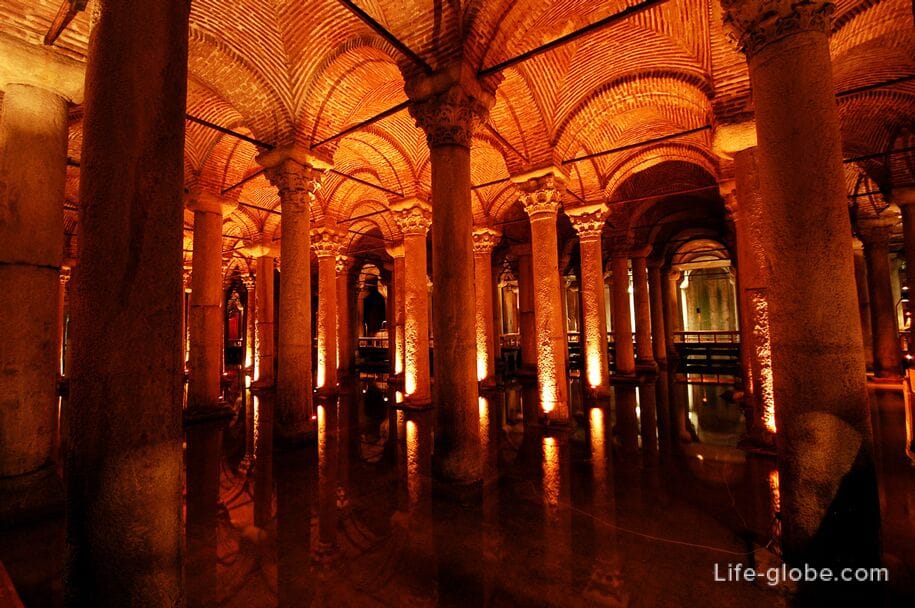
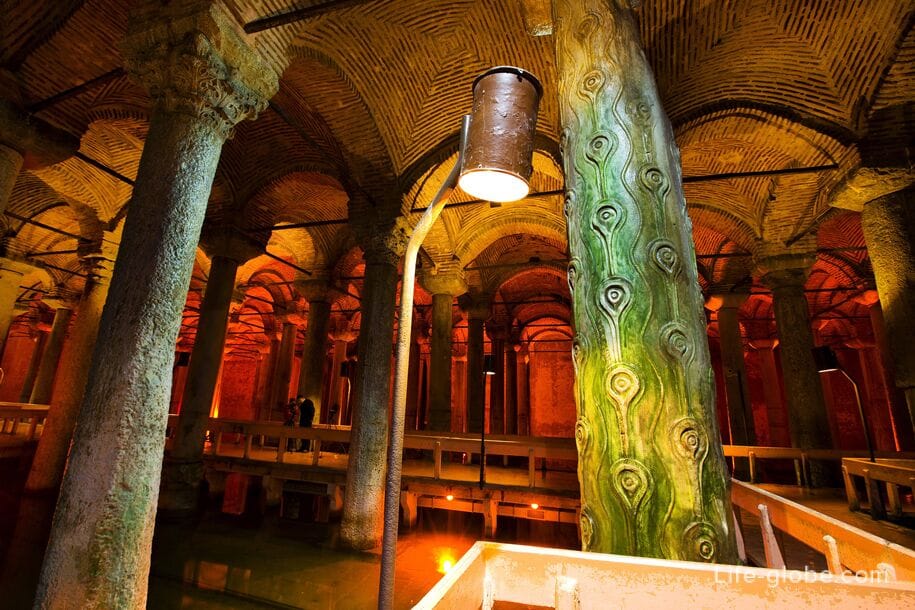
Mehmet Akif Ersoy Park is a memorial park with flower beds, recreation areas, monuments and small remains of the Antioch Palace (Antiochos Sarayı) and the Lausus Palace (Lausos Sarayı Kalıntıları).
The park is named after Mehmet Akif Ersoy (1873-1936), poet, writer, academician, member of Parliament and author of the national anthem of Turkey.
The Palace of Antiochus was an early 5th century palace in the Byzantine capital Constantinople. Some of the remains of the palace are still visible today.
The Palace of Laus dated back to the 5th century and its ruins with a dome are still visible on the western side of the former Hippodrome of Constantinople.
Mehmet Akif Ersoy Park is located near Sultanahmet Square.
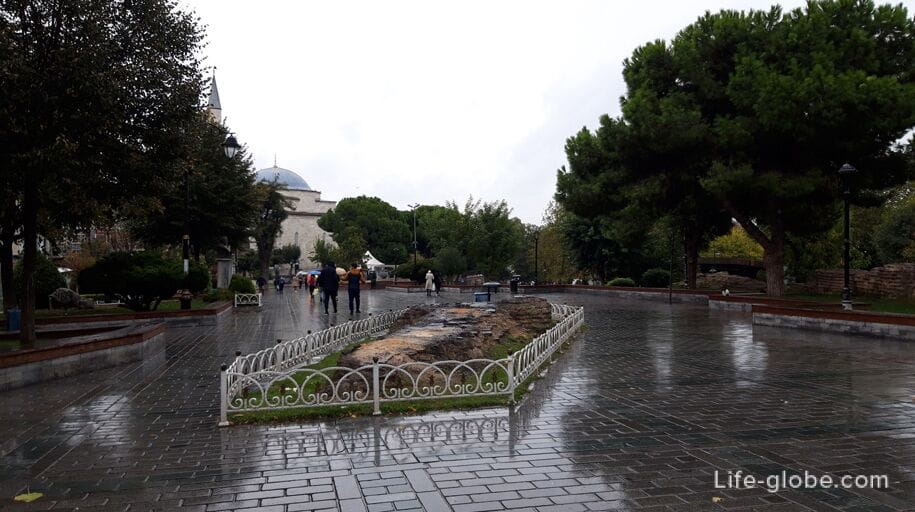
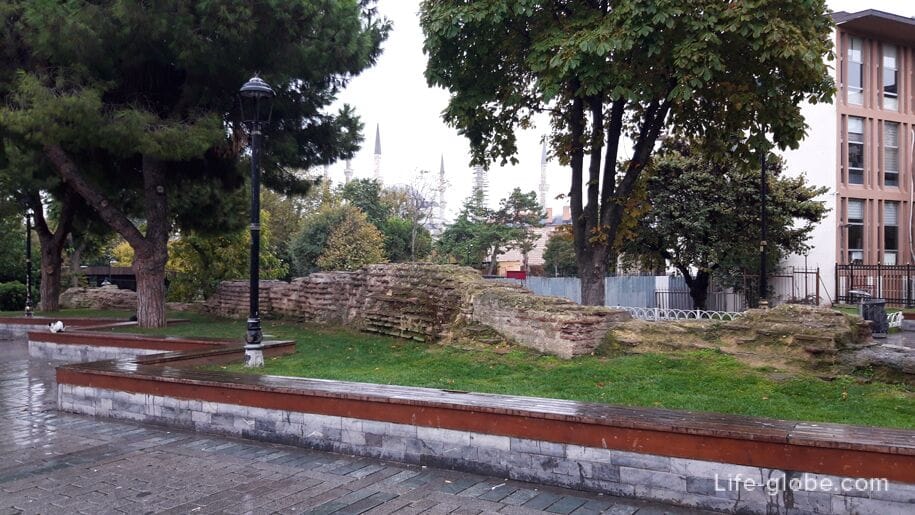
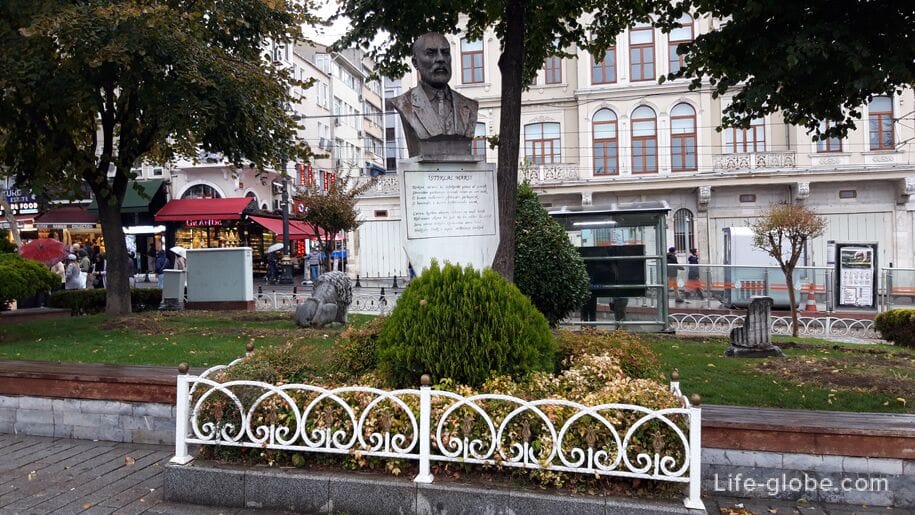
Near Sultanahmet Square, you can also see other small ruins of the ancient city.
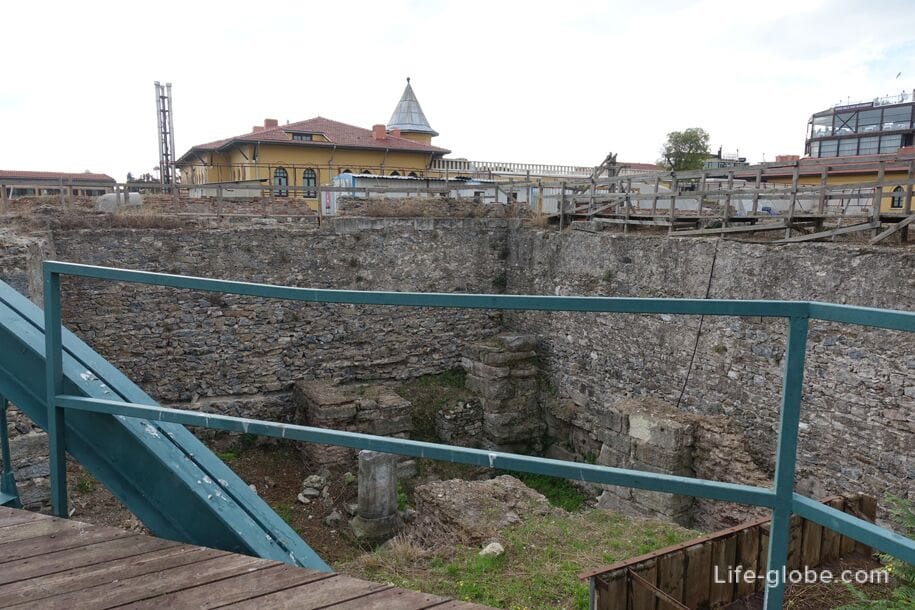
Firuz Agha Mosque (Firuz Ağa camii) is an Ottoman mosque of the 15th century, which was erected by Firuz Agha, the chief treasurer of Sultan Beyazit II.
This mosque is quite restrained in architecture and does not stand out in interior decoration. It has one minaret, a small courtyard and a marble sarcophagus of Firuz Agha.
The mosque is located near Mehmet Akif Ersoy Park.
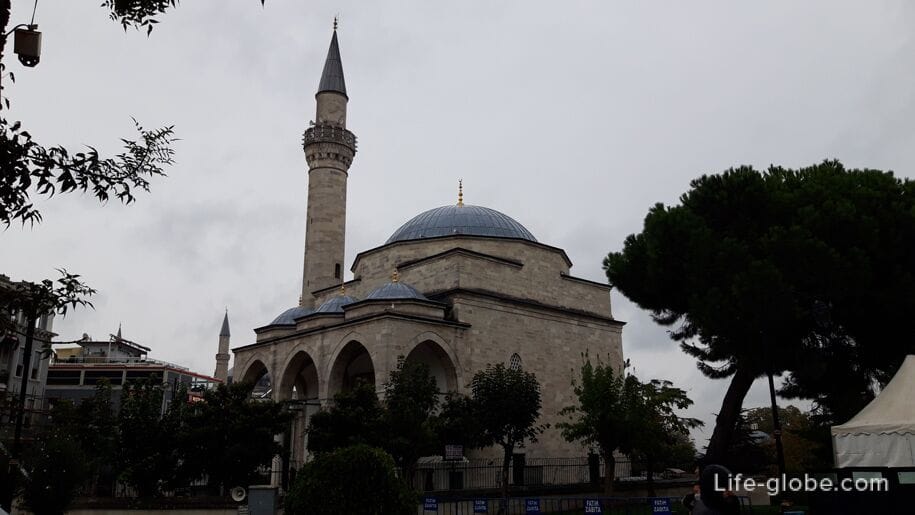
The Fountain of Ahmed III (III Ahmet Çeşmesi) is a large historical fountain located in a pavilion in the style of Ottoman rococo and looks like a richly decorated casket.
The fountain was erected during the reign of Sultan Ahmed III in 1728.
The fountain is a large square block with five small domes, luxurious decorations and paintings. At each outer corner of the pavilion, three barred windows (shebil) are notable, through which glasses of water or sherbet were given out free of charge. Fountains are located in the niches of the pavilion, above which there are large calligraphic plates with stanzas from a poem dedicated to water and philanthropist Seyid Hussein Wehbi ben Ahmed, the chief qadi of Aleppo and Kayseri. The poem is read clockwise around the fountain, starting from the northern shebil. The last stanza of the poem on the northwest facade depicts the chronogram of Sultan Ahmed III.
There is a fountain on a large square in front of the gates of the Topkapi Palace. More about the Ahmed Fountain 3...

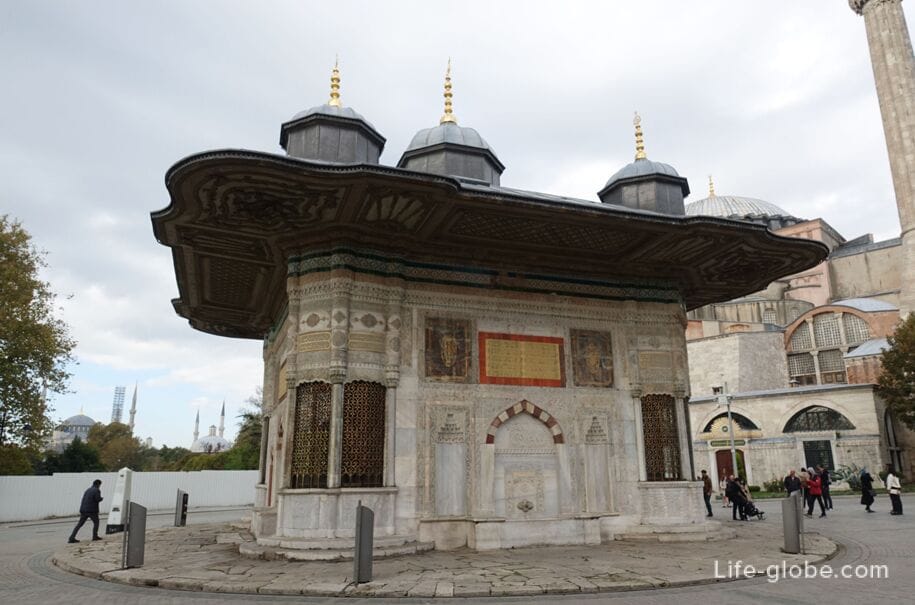
The Topkapi Palace (Topkapı Sarayı) served for 400 years as the main residence of the sultans of the Ottoman Empire, as well as the administrative and educational center of the state, until Sultan Abdul-Majida I moved to the newly built Dolmabahce Palace (Dolmabahçe Sarayı).
Today, the former Topkapi Palace is a museum, one of the main attractions of Istanbul, a magnificent architectural monument of the 15th-19th centuries and is a complex surrounded by high walls. The Topkaps include: courtyards and the palace complex itself with an administrative part and a harem, as well as other buildings and panoramic terraces. Also in the complex is the Church of St. Irene.
Entrance to the palace and the Church of St. Irene is paid.
Topkaps are located at: Cankurtaran Mh., 34122 Fatih / Istanbul.
Topkapi Palace website: topkapi-sarayi. More about Topkapi Palace...
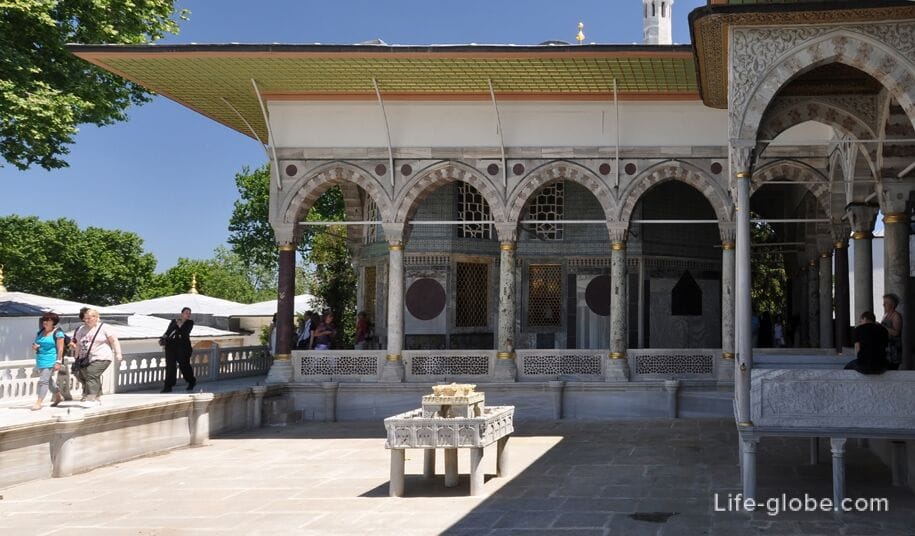
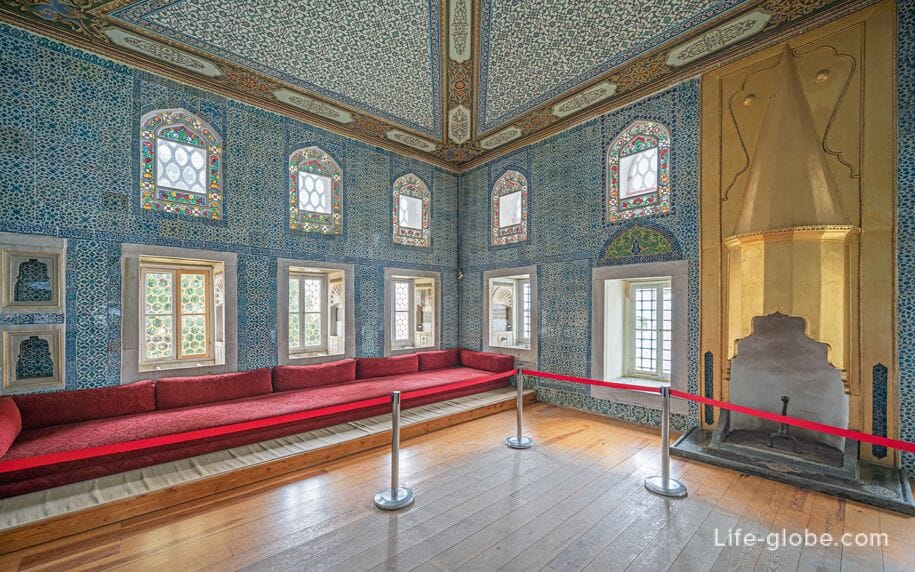
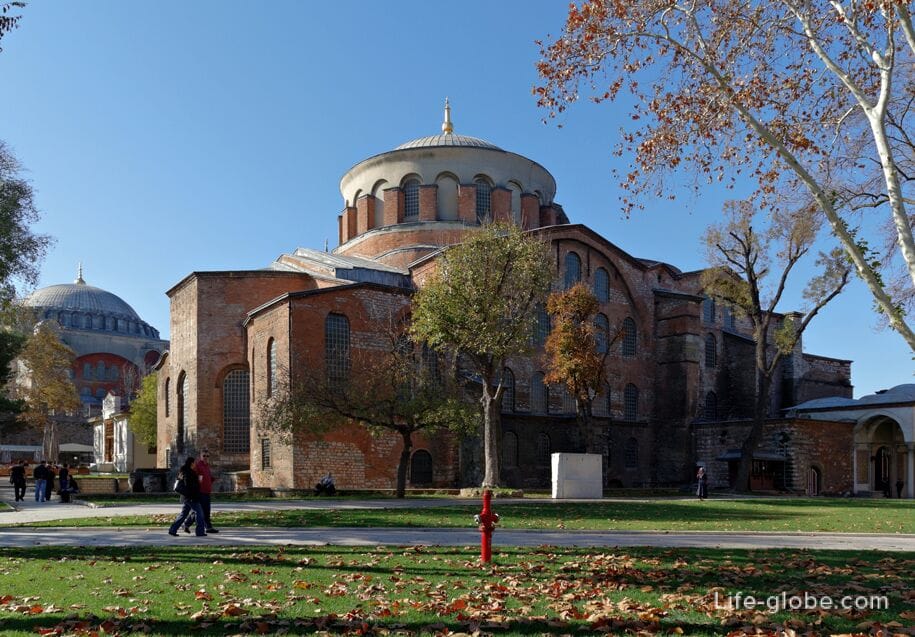
Near the walls of the Topkapi Palace there is a large Gulhane Park, which was the former outer park of the Topkapi Palace.
Today it is a public park with places for walking and recreation, cafes, fountains, monuments, historical objects and museums, including the Roman Gothic Column (Gotlar Sütunu), the Welcome Pavilion (Alay, Alay Köşkü), the Archaeological Museum of Istanbul (Istanbul Arkeoloji Müzesi) with the Museum of the Ancient East (Eski Şark Eserleri Müzesi) and the elegant tiled pavilion of 1472 (Çinili Köşk Müzesi / Repaired Keshk), as well as the Museum of the History of Science and Technology in Islam (Istanbul Islam Bilim ve Teknoloji Tarihi Müzesi).
Entrance to the park is free. Learn more about Gulkhan Park...



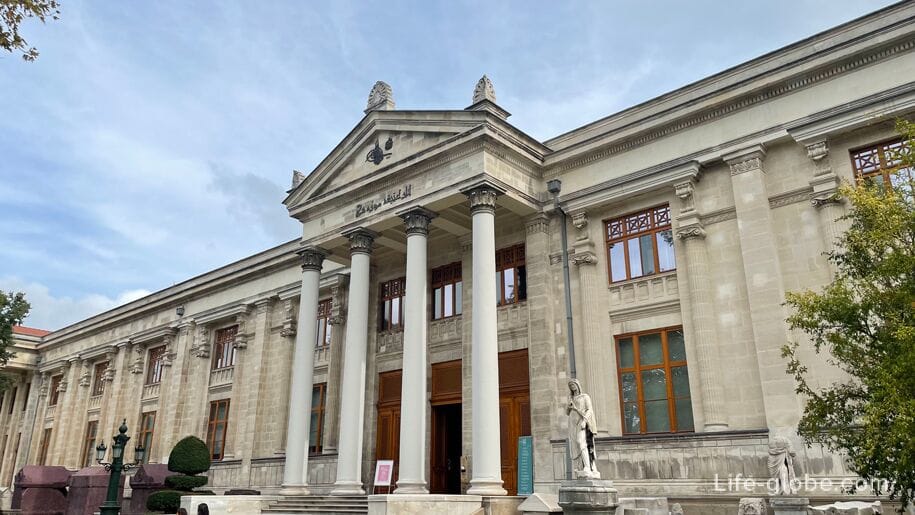
The High Gate or Sublime Porte, also the Ottoman Porte or High Porte (Sublime Porte, Bab al-Ali Sublime Porte) is a part (synecdoche) for the central government of the Ottoman Empire.
This name comes from the old practice when the ruler announced his official decisions and judgments at the gates of his palace. This announcement of decisions was a practice in the Byzantine Empire, and also adopted by the sultans of the Ottoman Turks since the time of Orhan I, and therefore the sultan's palace or the gate leading to it became known as the "High Gate".
Now they are known as the Imperial Gate (Bâb-Hümâyun) and led to the outer courtyard of the Topkapi Palace.
Today, an authority is located behind the gate.
The gate is located across the street from Gulhane Park, at Hoca Paşa, Alayköşkü Cd. No:29, 34110 Fatih/Istanbul, Turkey.
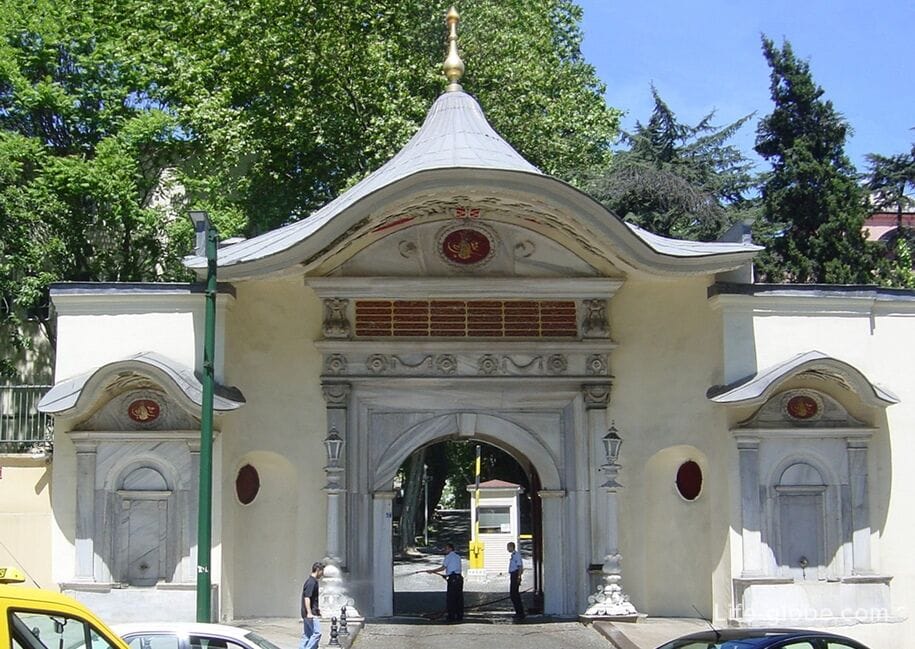
The Byzantine walls (Bizans surları) are located near the waters of the Marmara Sea (near the Topkapi Palace). Learn more about the fortifications of Istanbul: towers, fortresses, walls and gates...

Bukoleon Palace (Bukoleon sarayı) is a former palace of the Byzantine period dating from the reign of Theodosius II (5th century) and built near the waters of the Sea of Marmara.
Emperor Theophilus rebuilt and expanded the palace, adding a large facade on top of the walls facing the sea. In 969, Emperor Nikephoros II built a wall surrounding the palace complex. The Bucoleon remained the main palace of the Byzantine court until the 11th century, when the Komnenos dynasty built the Blachernae Palace in the suburb of Constantinople - Blachernae (now part of the city of Istanbul).
Today, small ruins with large arches and gardens remain from the palace. Not so long ago, the Istanbul Municipality announced that the palace will be restored and it is planned that it will become an open-air museum with a wooden walking path for visitors, a museum and a swimming pool.
The ruins of the Bucoleon Palace are located near the waters of the Marmara Sea, at: Sultan Ahmet, Kennedy Cd. No:40, 34122 Fatih/Istanbul, Turkey. More about Istanbul palaces...
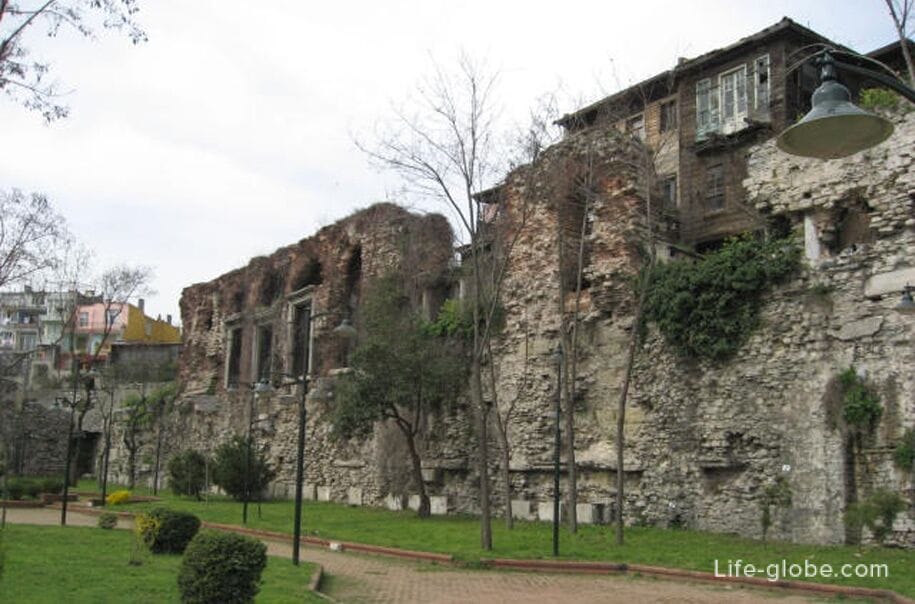
The Church of Saints Sergius and Bacchus (Küçük Ayasofya) or Little Saint Sophia (Kuzuk Ayasofya Caddesi) is a mosque in the building of the 6th century Byzantine church, which the Byzantines named after Sergius and Bacchus.
Since the temple looks like the Hagia Sophia, only it is smaller, the people called the shrine "Kyuchuk Hagia Sophia", which means "Little Hagia Sophia" or "Little Saint Sophia".
It is one of the oldest preserved churches in Istanbul. The existing temple was built in 527-529 near the house where Emperor Justinian I spent his young years. The fact that the church of Saints Sergius and Bacchus was especially loved by the imperial family is evidenced by the fact that the initials of Justinian and Theodora are applied to many capitals.
After the fall of Constantinople, the church of Saints Sergius and Bacchus continued to operate until 1506, when it was converted into a mosque, where mosaics were whitewashed, a porch and a madrasah were added.
In 1742, a ritual fountain was built in the courtyard of the building, and in 1762 a minaret appeared (completely rebuilt in 1952). Sultan Mahmud II ordered the renovation of the mosque after repeated earthquakes.
The address of the church-mosque: Küçük Ayasofya Mahallesi, Küçük Ayasofya Camii Sokagi No:20, 34122 Fatih/Istanbul, Turkey.


The Sokullu Mehmet Pasha Mosque (Sokullu Mehmet Paşa camii) is a fairly large and well-known mosque of the city.
The mosque was built in the Ottoman style in 1572 on the site of the church of St. Anastasia, parts of the ruins of which were involved in the construction of the mosque.
The mosque is named after the Grand Vizier Sokollu Mehmed Pasha.
The mosque has one minaret and a courtyard. The interior of the mosque is known for Iznik tiles decorating the interior walls.
The mosque is located in the historical part of Istanbul, in the Kadırga neighborhood. Learn more about mosques, cathedrals and churches in Istanbul...
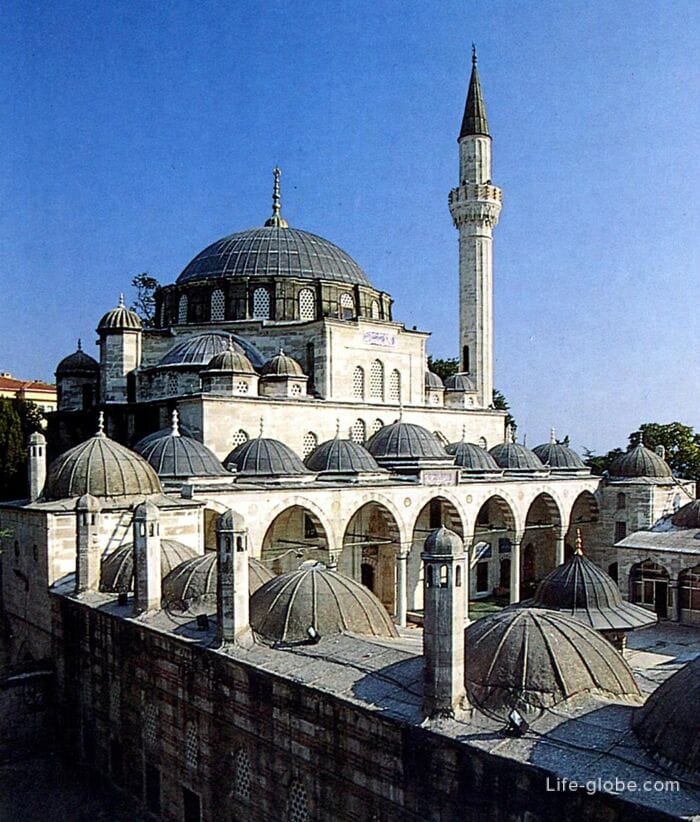
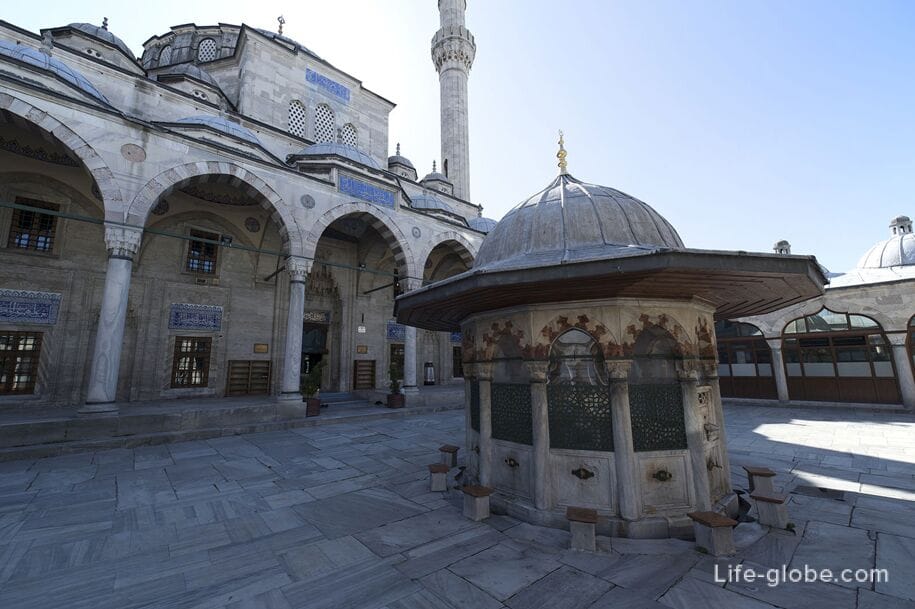
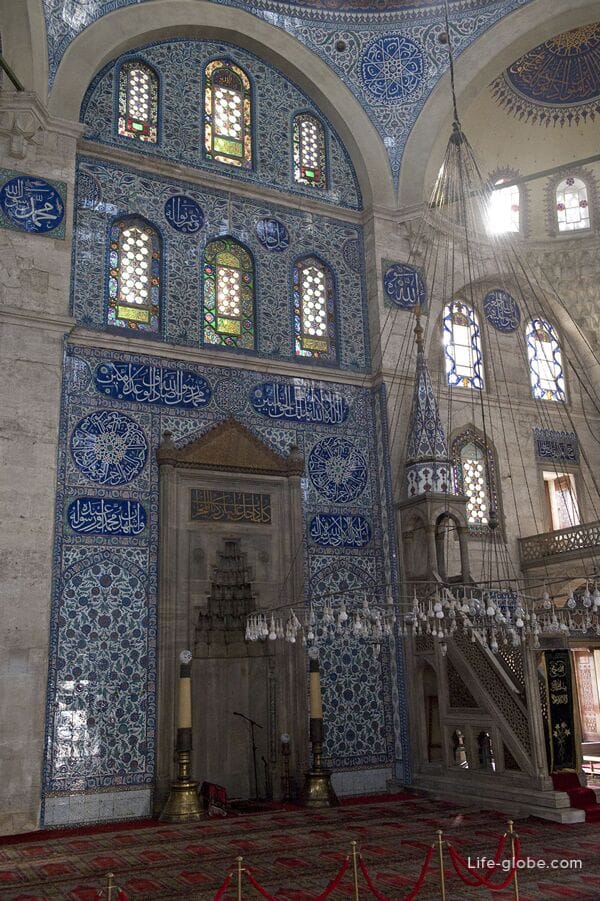
There are many cafes and restaurants in and around Sultanahmet, including Turkish cuisine and fish.
From the catering stands out the cafe-restaurant of Turkish cuisine "Palatium Cafe and Restaurant" with the remains of the Magnaura Palace (Magnaura Place), located at: Kutlugün Sok., No. 33, Sultanahmet, Fatih.
There is also a network of dessert cafes "Hafiz Mustafa 1864" with a variety and delicious baklava and other desserts. Learn more about Hafiz Mustafa dessert cafes with photos and website...
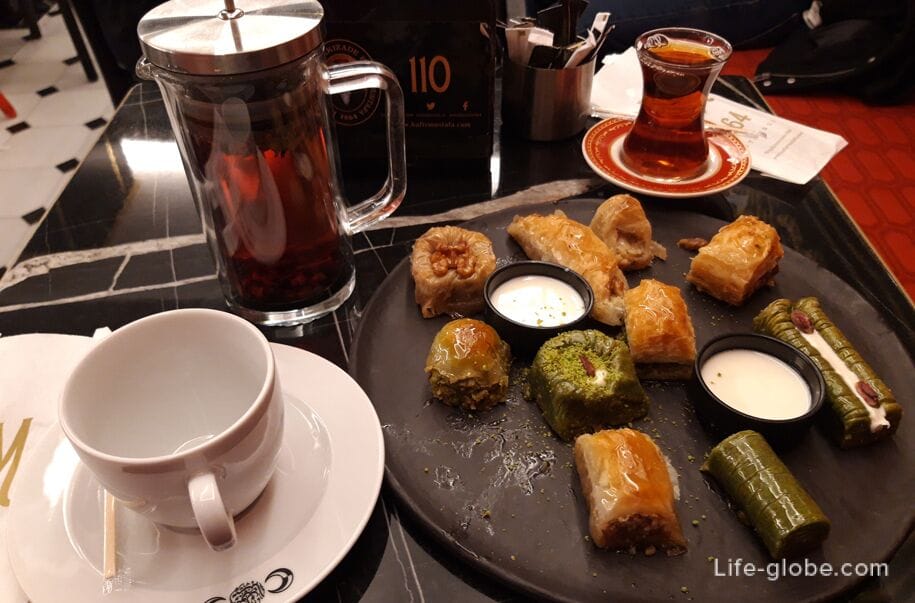
Get to the center of Sultanahmet district (Sultanahmet Square) you can walk from the ferry piers near Galata Bridge; from the tram stop T1 "Sultanahmet"; from the metro station Vezneciler (green line M2) on foot about 1.8 kilometers. You can also get to taxi, by rented car, or by taking a tour on the Istanbul Hop-On Hop-Off tour bus (there are tickets for 1, 2 or 3 days).
Tickets for the Istanbul sightseeing bus can be purchased here →
The 4-star Deluxe Golden Horn Sultanahmet Hotel offers Ottoman-style rooms, a restaurant with a terrace overlooking the Marmara Sea and the Istanbul skyline, a fitness center, free Wi-Fi and a 24-hour front desk.
The rooms are equipped with double-glazed windows, air conditioning, a flat-screen TV with satellite channels, a minibar, a safe, a hairdryer, slippers and free toiletries.
A buffet breakfast is included in the room rate. Link to the hotel
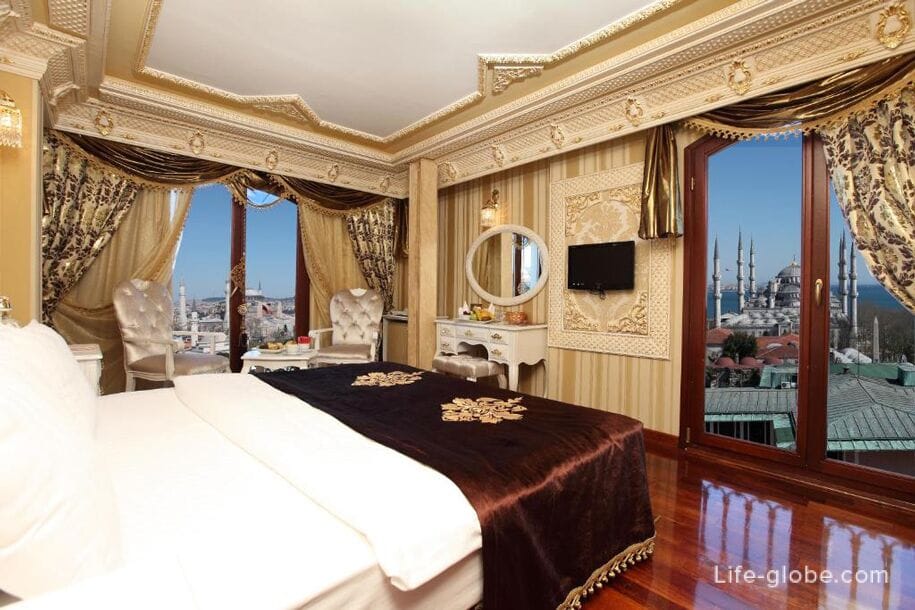
The 4-star Lady Diana Hotel features a rooftop restaurant with panoramic views of the Blue Mosque.
Also at the hotel: spa with hammam, bar and free Wi-Fi.
The rooms are equipped with air conditioning, carpets, wooden furniture, a flat-screen TV, a minibar and a private bathroom.
Breakfast is included in the room rate. Link to the hotel

Harmony Hotel Istanbul & SPA is a 4-star hotel with a rooftop terrace with panoramic views of the Marmara Sea.
The hotel is located in an Ottoman-style building and features a bar, free parking and Wi-Fi.
The rooms are decorated in soft neutral tones and feature floor-to-ceiling windows. Each room is equipped with a minibar, satellite TV, a safe and a private bathroom with a hairdryer and free toiletries.
Breakfast may be included in the room rate. Link to the hotel

Boutique Saint Sophia is a 4-star boutique hotel located in a renovated historic building of the 19th century.
In the hotel: cafe, bar, free parking and Wi-Fi.
The rooms are equipped with: air conditioning, iPod docking station, flat-screen TV with satellite channels, free minibar, bathrobes and toiletries.
Breakfast may be included in the room rate. Link to the hotel

The Best Point Hotel Old City is the Best Group Hotels where in summer guests can enjoy the sunset from the roof of the hotel, where free coffee, tea and soft drinks are offered. Guests can also enjoy a free buffet with snacks, soft drinks, canapes, cakes and cookies.
The hotel's rooms are decorated in Turkish style and warm colors. They are equipped with a flat-screen TV, tea/coffee making facilities and a private bathroom with a spa bath. Some apartments have a Turkish bath.
Free Wi-Fi is available throughout the hotel.
Breakfast is included in the room rate. Link to the hotel

Apart-hotel Q Hotel & Suites Istanbul -Best Group Hotels with a cafe-restaurant, 24-hour room service, 24-hour front desk, free parking and Wi-Fi.
The hotel's shared terrace overlooks the Marmara Sea.
The air-conditioned rooms are fitted with parquet floors, a minibar, a safe, a flat-screen TV and an electric kettle. Featuring a shower, the private bathroom also comes with a hairdryer and free toiletries. Link to the hotel
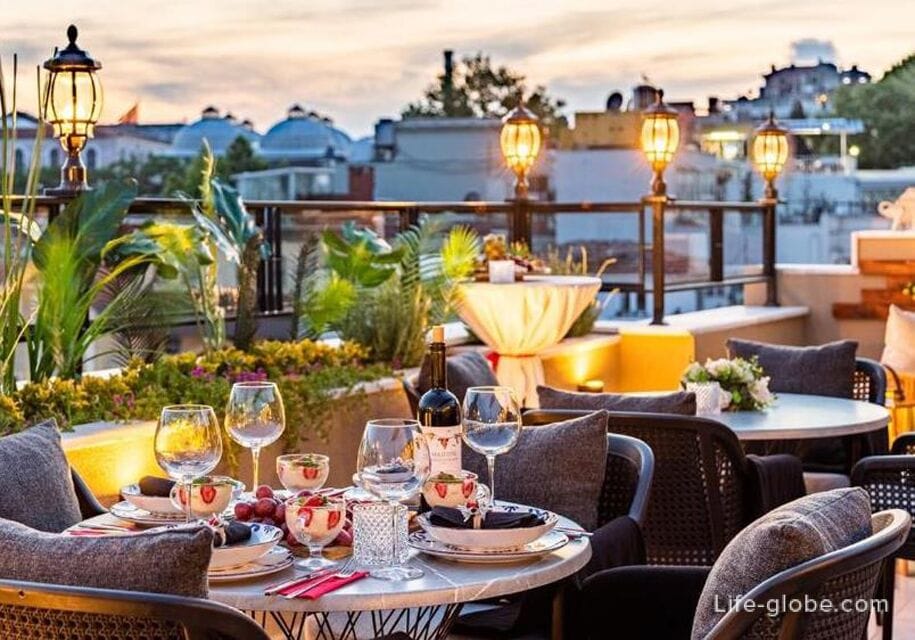
All accommodation facilities in Istanbul, including in the historical center of the city and more remotely from it, can be viewed and booked here